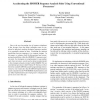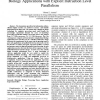418 search results - page 2 / 84 » Parallel Computation in Biological Sequence Analysis |
CF
2009
ACM
13 years 11 months ago
2009
ACM
The exponential growth of databases that contains biological information (such as protein and DNA data) demands great efforts to improve the performance of computational platforms...
CANDC
2000
ACM
13 years 4 months ago
2000
ACM
A new statistical model for DNA considers a sequence to be a mixture of regions with little structure and regions that are approximate repeats of other subsequences, i.e. instance...
AINA
2006
IEEE
13 years 11 months ago
2006
IEEE
Due to the ever-increasing size of sequence databases it has become clear that faster techniques must be employed to effectively perform biological sequence analysis in a reasonab...
ISCAPDCS
2007
13 years 6 months ago
2007
—The tremendous growth in the information culture, efficient digital searches are needed to extract and identify information from huge data. The notion that evolution in silicon ...
WOB
2003
13 years 6 months ago
2003
The maximum subsequence problem finds the contiguous subsequence of n real numbers with the highest sum. This is an important problem that arises in several contexts in Computatio...


